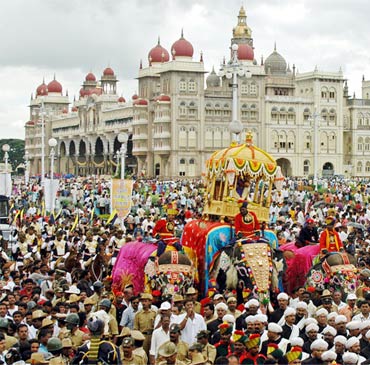Every year, Dussera, a prominent Hindu festival, is a holiday in India. And interestingly in our childhood, Dussera was about climbing dad’s shoulder to witness the flames, burning the tall effigies of demon king Ravana and the crackle of crackers. The fairs and the festivities and a dose of message he used to give us, of always doing good in life.
Today though this day has turned into lazy mornings and holiday mood, but the childhood messages and memories still flashes before my eyes every year.
Hi, again I am here to take you around another festival Vijay Dashmi
But what is actually Dussera?
Dasara, Dusshera or Vijaydashmi marks the ending of the 9 day long festival of Navratri ( the festival of Goddess Durga) and beginning of the preparation of the upcoming festival Deepawali. It falls on the 10th day of the Hindu calendar month ‘Ashvin’, generally in the month of September-October-November according to different ‘Tithis’ or dates every year.
As Dusshera is celebrated on the 10th day of the Hindu calendar and marks the victory, hence it is called ‘Vijaydashmi’ (Vijay meaning victory and ‘Dashmi meaning 10th day.)
The ‘Kahani’ behind it.
As every festival has many different tales attached to it from the Indian epics, so does Dusshera, the most famous being, one from the Ramayana, which is quite known and widely spoken.
As the story goes, Dusshera is celebrated to commemorate the killing of Demon king of Lanka Ravana by Lord Ram after Goddess Sita(Ram’s wife) is freed from the demon’s abduction. Demon king Ravana had 10 heads, and so it was a mammoth task to kill him, but finally when he was killed the whole kingdom rejoiced and Rama and Sita came back to Ayodhya, their kingdom, which is later celebrated as Diwali.
The other story which holds significance for the eastern side of the country is, on Dusshera the Durga puja ends and marks the ending of ‘adharma’ and setting up of dharma, when goddess Durga kills the buffalo demon ‘Mahisasur’
Celebration
The celebration of Vijaydashmi varies significantly in different parts of the country, though the inherent message and theme remains the same. ‘The victory of good over evil’.
In the northern part of the country, it comprises of burning of towering effigies of Demon King Ravana, and his brothers Meghnath and Kumbhkaran . The effigies are huge, sometimes as tall as 110 feet. The workers and artisans start working on it since a month back preparing it with light weight materials stuffed with hay, and crackers. Person Portraying as Rama ( generally a revered person , who may be an elder, or a leader or may be a kid, as chosen by the gathering ), lights the effigies through an arrow. The effigies burn and falls with a thud symbolizing the end of evil.


In the Bengali’s, the Dusshera is marked with the procession which is taken by the women of the house, all clad in white and red saris, before the Durga idol is immersed. During this ‘Sindoorkhela’ is seen. The ladies apply sindoor(vermillion) onto each other’s face and embrace each other . After the Durga idol (made from clay, and worshipped for 9 days ) is immersed, people visit to each other houses to pay respect .

In the southern part of the country, primarily in Mysuru city in Karnataka state, Mysore Dasara has an all together different pomp and show. It marks a great tourist attraction. The Mysore palace , a huge ancient palace is decorated and lighted up and is a great visual delight to watch . A huge processions with elephants are also seen around the palace.


In many parts of South India , Dasara is also attributed to goddess Saraswati and books are worshipped. A similar tradition is followed in Maharashtra, wherein books, stationary and source of knowledge and tools of work are worshipped.
On this day vehicles, are also worshipped and along with it shops and residence are decorated with garlands made of marigold. Almost every vehicle, new or old has a beautiful yellow- orange garland around it. An important tradition also speaks of, distributing the leaves of ‘Aptya’ considering it as gold to each other. The leaves are also called ‘sonpatta’ or the trees with leaves of gold.

The intended Message,
On a mythological reference it marks the victory of a God over a demon. But on today’s scenario, it marks the victory of good over evil. Victory of our goodness over our inner evils and hatred. It is celebrated to cleanse the evil present inside us and substitute it with goodness and kindness.
Dusshera also signifies that a wrong intention and company can lead you to your doom. Ravana was a very learned and intellectual individual but his arrogance, pride , ego and anger lead to his destruction.
It proclaims that however strong or big the evil is, one day the good takes it over giving it an end. It teaches us to kill the bad qualities of Ravana in us and try inculcating the goodness of Ram.
May you win over your inner demons and lead a peaceful, wonderful life.
Wish you and your family a very happy, prosperous and Shubh Dusshera

Nicely written and explained..😊👌
I am glad that you liked it. thank you so much.
Please do give your feedback on my other articles as well.
And visit my another blog too. http://www.divyankaagarwal.wordpress.com
Thanks in advance
have a great day
Sure.. I’ll be glad to do so. 😄✌